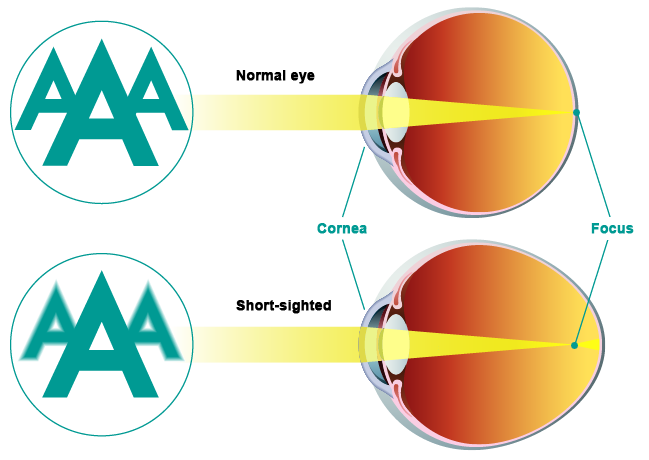Short-sightedness
Myopie
Short-sightedness is a type of refractive error where good vision is given when looking at close objects but when the image becomes blurry when looking at distant objects. The eyes of people with normal vision manage to concentrate incoming light on the retina. This process is rendered possible by the so-called dioptric apparatus. The reason for myopia lies in a disproportion between the length of the eyeball and the refractive power of the eye. This disproportion causes light coming from distant objects to be focussed not on the retina but in front of it. For short-sighted people, the far point (the farthest point from the eye at which images are clear) does not lie in an infinite distance but rather close to the eye.  Myopia can occur in two different forms. In the case of refractive myopia, the refractive power of the dioptric apparatus is too strong compared to the length of the eyeball. This condition can be caused by an opacification (clouding) of the lens (cataract), a weakness of the suspensory ligaments of the lens (zonular fibres) or by a deformation of the cornea. As regarding to axial myopia, the refractive power of the eye is normal while the optic axis is too long. In this case, hereditary factors can play an additional role.
Myopia can occur in two different forms. In the case of refractive myopia, the refractive power of the dioptric apparatus is too strong compared to the length of the eyeball. This condition can be caused by an opacification (clouding) of the lens (cataract), a weakness of the suspensory ligaments of the lens (zonular fibres) or by a deformation of the cornea. As regarding to axial myopia, the refractive power of the eye is normal while the optic axis is too long. In this case, hereditary factors can play an additional role.
 Myopia can occur in two different forms. In the case of refractive myopia, the refractive power of the dioptric apparatus is too strong compared to the length of the eyeball. This condition can be caused by an opacification (clouding) of the lens (cataract), a weakness of the suspensory ligaments of the lens (zonular fibres) or by a deformation of the cornea. As regarding to axial myopia, the refractive power of the eye is normal while the optic axis is too long. In this case, hereditary factors can play an additional role.
Myopia can occur in two different forms. In the case of refractive myopia, the refractive power of the dioptric apparatus is too strong compared to the length of the eyeball. This condition can be caused by an opacification (clouding) of the lens (cataract), a weakness of the suspensory ligaments of the lens (zonular fibres) or by a deformation of the cornea. As regarding to axial myopia, the refractive power of the eye is normal while the optic axis is too long. In this case, hereditary factors can play an additional role.How myopia becomes noticeable
In most cases, short-sightedness manifests itself for the first time at the age of 10 to 12 years and increases until the age of 20. However, high myopia (more than 8 dioptres) can already develop in an early childhood and continue to increase for the rest of one’s life. Very often, it is a congenital condition which can cause a detachment of the retina and lead to the loss of sight if treatment is not sought.Recommended treatment options
The various treatment options for short-sightedness are related to different factors. Depending on the number of dioptres and the structure of the eye, the following methods can be discussed during the consultation with a surgeon:- Femto-LASIK
- LASIK
- PRK
- Epi-LASIK
- Lens surgery
